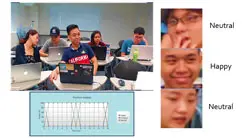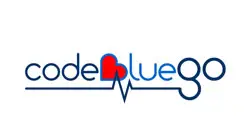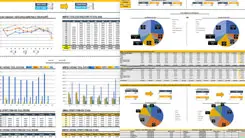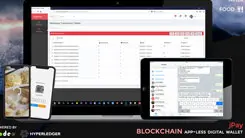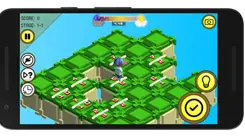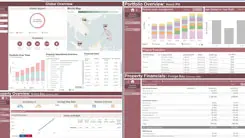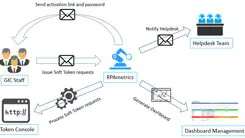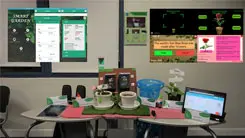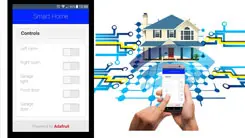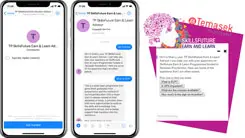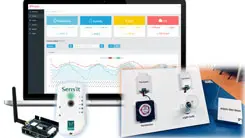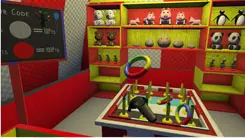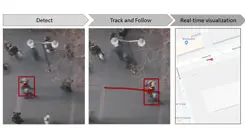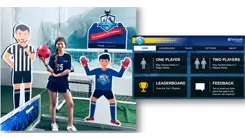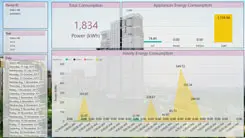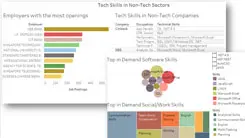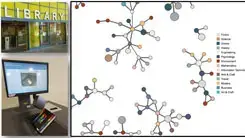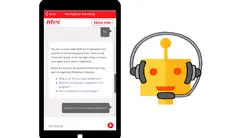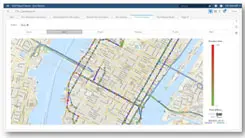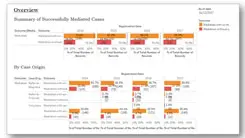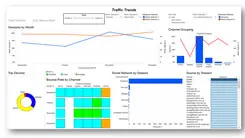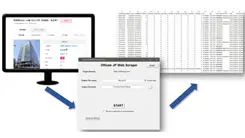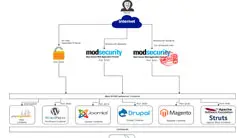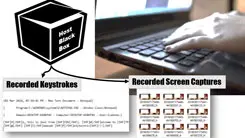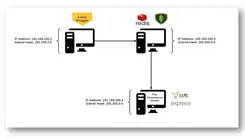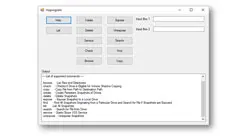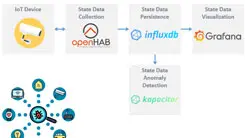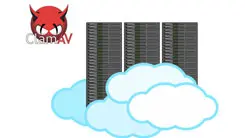
Future of Tech & Fintech
A Virtual Reality Simulation for Culinary Students
Project Background
Students from Temasek Polytechnic’s Diploma in Culinary & Catering Management are required to practise table-setting skills as part of their training. However, practising with real cutlery and tableware is inconvenient as time is spent on the preparation and cleaning up.
Culinary VR is a single-player educational simulation game which simulates a table-setting test taken by the students. It recreates the test environment as accurately as possible, and follows all the test procedures. The game features two modes: a guided mode and a test mode. The guided mode takes the student virtually through the correct procedures they should follow to pass the test. The test mode puts them in a real test environment where they are timed and scored based on their performance. Culinary VR also has a leaderboard feature for students to compare their performance with others.
Key Benefits
- Convenient – Culinary students can practise for their test without having to prepare cutlery and other tableware.
- Cost-effective – Practising in a VR simulation means there is no risk of breaking expensive, fragile tableware.
Key Technologies Used
- Autodesk Maya
- HTC Vive
- Unity 3D
Potential Opportunities
This application can be enhanced with the following:
- Providing for training of waiters in other skill sets in the F&B industry such as clearing of tables.
Project Team Members
- Mohamed Faez Bin Shahlan (Project Leader)
- Sanford Donavern Ang Rui Xian
- Teo Ming Enn
Industry Partner
Temasek Polytechnic’s Diploma in Culinary & Catering Management
Supervisor
Mr Tan Hong Yap
Analysing Students' Emotions
Project Background
Have you ever wondered what your students are feeling in class? How do you gauge if a lesson activity was well-received? Let Emotion Recognition analyse your students’ emotions and reactions to decipher what they are feeling.
Emotion Recognition is a Windows application that assists in recording and analysing students’ emotions and reactions during lessons. Using Microsoft Cognitive services, the programme captures and analyses the various faces detected and then displays the corresponding emotions identified. This data is captured into a live chart and a database so teachers can easily measure students’ emotions during lessons. Teachers are also able to view the historical data for future research to make lessons more engaging.
Key Benefits
- Efficient – Teachers can find out what their students are feeling by simply letting the programme run during their lessons.
- Easy to Use – This is a simple programme to navigate and use. Teachers can easily run the programme without disrupting their lessons.
Key Technologies Used
- Microsoft Cognitive Services
- C#
- XAML in Visual Studio
Potential Opportunities
This application can be enhanced with the following:
- Used in events to understand and analyse audience’s experience.
- Deployed as an interactive tool to gauge customers’ satisfaction.
Project Team Members
- Nurul Aini Bte Azri
- Thien Yun Kai
Supervisor
- Ms Chew Li Peng, Jamie
- Mr David Wang Yanbin
Clinical Training using Augmented Reality
Project Background
Nurses need to be trained to manage high-risk clinical events such as Code Blue situations. Conventional training methods typically use high fidelity mannequins to simulate scenarios. However, these lack realism as mannequins are unable to depict the urgency and the context of the emergency event.
Mannequin Augmentation is an educational training simulation combining the use of augmented reality (AR) with high fidelity mannequins. Using AR technology, the application is able to overlay information and graphics onto the mannequins, enabling trainees to obtain a visual and tactile sense of emergency situations. Thus, it will bring a new dimension of realism by allowing mannequins to portray emotions such as sadness or pain, and psychological symptoms such as confusion.
This project was showcased at the inaugural S3 Conference 2017 during the keynote speech by Integrated Health Information Systems. This conference has close to 500 of the world’s leading experts from Singapore, Europe and USA, which lead the transformation of medical simulation in the region.
Key Benefits
- Realistic – Trainee nurses are able to receive authentic training experiences through visual and tactile sense of emergency situations.
- Responsive – Instant feedback provided is able to prompt and guide the nurses in managing the patients’ needs.
Key Technologies Used
- Unity 3D
- Autodesk Maya
- Visual Studio
Potential Opportunities
This application can be enhanced with the following:
- Addition of more clinical symptoms such as inflammation and changing of skin tone
Project Team Members
- Ahmad Iqbal Bin Othman
- Darryl James Rosario Arado
- Goh Yong Heng
- Liu Zhongheng
- Muhammad Adli Bin Jumahat
- Ng Zheng Jie Samuel
Industry Partner
- Ng Teng Fong General Hospital
- Advanced Remanufacturing and Technology Centre (ARTC)
Supervisor
Mr Tan Hong Yap
Code Blue Go – A Simulation Game for Nurses
Project Background
Code Blue Go is a simulation game developed for the Institute of Mental Health as a tool to facilitate training and assessment of nurses in preparation for a Code Blue event.
Code Blue Go takes the user through a series of live action interactive videos which test the user’s knowledge on the numerous procedures during a Code Blue scenario through question prompts and mini-games.
Due to the ever-changing nature of the Code Blue procedure, Code Blue Go was created to be completely modular in design. Updated segments of the Code Blue procedure need only be re-filmed to replace outdated footage without the need to re-film the entire process. To fulfil the need for assessment of trainee staff, Code Blue Go tracks user performance throughout their play-through and provides teaching staff performance metrics such as the time taken to complete resuscitation and the number of failed attempts.
Key Benefits
- Portable – Allows users to practise anytime and anywhere.
- Comprehensive – Covers all the important details involving the Code Blue procedure.
Key Technologies Used
- Unity 3D
- Adobe Premiere CC
- Reaper
Potential Opportunities
This application can be enhanced with the following:
- Expanding to include training of nurses in other hospitals.
- Porting to mobile platforms such as Android and iOS systems.
Project Team Members
- Tay Yan Chong, Clarence (Project Leader)
- David Chew Zhi Heng
- Loh Yong Zheng
- Ng Zheng Kai Justin
Industry Partner
Institute of Mental Health
Supervisor
Mr Lim Kang Woei, Sean
Eikon Excel Dashboard
Project Background
The Eikon Excel Dashboard is an analytical tool that bridges the gap between raw data and analysis. It is designed to assist users in assessing and analysing the factors driving the energy market. The Excel dashboard is integrated with an Excel plug-in feature, Eikon Excel, that extracts data directly from the Thomson Reuters database on a real time basis.
The real time datasets and intuitive visual aids presented across the dashboard will assist users in conducting their research and exploring potential trends, such as price, demand, supply, in the energy market. Furthermore, the dashboard allows users to customise the way the data is being presented using charts for better data analysis.
Key Benefits
- Customisable – Table content and charting can be customised according to user selection of demand/supply source or time period.
- Real-time – Users are viewing the latest market data as it is automatically refreshed at a fixed time interval.
Key Technologies Used
- Thomson Reuters Eikon Excel plug-in
- Microsoft Excel Formulas
Potential Opportunities
This application can be enhanced with the following:
- Ability to offer the dashboard on different platforms besides Microsoft Excel.
- Inclusion of energy market news articles to facilitate fundamental analysis.
Project Team Members
- Amos Khoo Yong Jun
- Chen Bing Sen
- Zhang Xiaoyue
Industry Partner
Thomson Reuters
Supervisor
Mr Wong Kok Keong
JPay Blockchain Payment System
Project Background
JPay is an application system that has an integrated digital wallet for secured cashless payments. The system allows users to keep track and monitor their transactions using a highly intuitive, user-friendly dashboard.
JPay uses blockchain technology to allow transactions to be completed without a middleman, such as banks. Security is ensured by the encryption of all sensitive data with the Secure Hash Algorithm (SHA-256), and the use of token authorisation and Two Factor Authentication (2FA) technology.
JPay can easily be adopted by integrating it onto any platform that has a http web interface, for example, Telegram chatbots or HTML5 web applications.
Key Benefits
- Secure – Transactions are processed securely using various encryption and authorisation methods.
- Convenient – Users can easily make payments on-the-go via chatbots on existing social media platforms.
Key Technologies Used
- Framework: Hyperledger Fabric, BrainTree, RESTful Web API
- Programming Languages: NodeJS, AngularJS, ReactJS, HTML, CSS, GoLang
- Database: MongoDB, MsSQL, Azure DocumentDB, Azure Queue Store
- Virtual Machines: Docker Engine, Linux Server VM
Potential Opportunities
This application can be enhanced with the following:
- Incorporating Artificial Intelligence and Machine Learning for merchants to gain insights on customers’ needs and customer retention.
- Automating payments using GPS, NFC and sensors to ensure a hassle-free shopping experience.
Project Team Members
- Caleb Cheong
- Lim Jingheng Shawn
- Tan Tze Yong Thaddeus
- Yip Hou Liang
Industry Partner
Jungle Element
Supervisor
Ms How Woan Ling
Numerelic 2 – A Game for Teaching Math
Project Background
Numerelic 2 is a mobile educational game that trains primary school students in solving mathematical problem sums. Players can select their chosen level, from Primary 1 to Primary 6, and then select from among three unique and different game modes.
When players start the game, they will be playing as a video game character on a floating platform. A question would be posed to the player and multiple answers would be spawned on the floating platform. Players can earn rewards such as time boosts and in-game points to unlock skins to personalise their game character. As they become more experienced, players can challenge themselves and set a high score on the leaderboard, or compete against other players in real time.
Key Benefits
- Convenient – Play the game and learn mathematics on the go.
- Engaging – Learn mathematics in a fun environment and be rewarded.
- Progressive – Develop a better understanding of concepts through daily, gradual progression.
Key Technologies Used
- Unity 3D
- Adobe Creative Cloud
Potential Opportunities
This application can be enhanced with the following:
- Ability to be developed as an online multiplayer game.
- Ability to expand by adding more question types such as graphs and pictures.
Project Team Members
- Jarno Jegor De Lacy (Project Leader)
- Mah Jin Zhen
- Mohamed Norazlan Shah B Amran
- Ng Zu Yong
Industry Partner
Pasir Ris Primary School
Supervisor
Mr Malcolm Stuart Grant
Rental Property Performance Dashboards
Project Background
The Rental Property Performance Dashboards project is a set of business intelligence dashboards that are designed to help senior management and investment managers in making effective investment decisions in the real estate serviced apartment property sector.
The dashboards present the key performance indicators and historical trends of specific rental property investments which aid the investment team in making more informed analyses. Each dashboard allows for further drilling down to various levels of hierarchy such as country, portfolio and property. This provides the team with more powerful insights and diverse investment perspectives, in order to enable them to either invest further in that portfolio or to cut their losses.
Key Benefits
- Dashboard Automation – Updates automatically according to a pre-scheduled timing.
- Data Visualisation – Provides users with powerful insights to aid in investment decisions.
Key Technologies Used
- Tableau
Potential Opportunities
This application can be enhanced with the following:
- Comparisons to other real estate investments such as retail and hospitality investments.
- Tracking of specific property-related investment information via email notifications.
Project Team Members
- Yeo Yuan Xin
Supervisor
Ms How Woan Ling
RPAmetrics – An Automation Tool
Project Background
RPAmetrics is a Robotic Process Automation (RPA) application that automates the software token request process. The software token is a mechanism that is used to perform Two Factor Authentication (2FA) in order for staff to access the Intranet from outside the office.
RPAmetrics comprises various components to extract software token request emails from the server, process these requests and log the data of all processed requests. Based on the data collected, RPAmetrics will generate a dashboard which provides an overview of the software token request performance.
This project was developed for the Helpdesk team at the Technology Department of GIC Private Limited to process software token requests from the staff members.
Key Benefits
- Reduces human labour – Minimises the need for human intervention in the software token request process.
- Eliminates human error – Provides error-free processing of the software token requests.
- Increases efficiency – Reduces the processing time from 10 minutes to 4 minutes per request.
Key Technologies Used
- C#
- VoiceMacro application
- HTML
- JavaScript
- Highcharts
Potential Opportunities
This application can be enhanced with the following:
- Automation of other repetitive and manual tasks such as banking approval processes.
Project Team Members
- Li Hao
Industry Partner
GIC Private Limited
Supervisor
Mr Lim Beng Kee, Ryan
Smart Garden System
Project Background
Are you always too busy to check on your plants? Have you forgotten to water them regularly? With the Smart Garden System, you can sit back, relax, and let technology take care of your plants.
The Smart Garden System automatically monitors the environment to make sure that your plants stay healthy. This Internet of Things (IoT) solution includes sensors, an automated water irrigation system and a mobile application. When unfavourable conditions are detected, such as low water levels, the system triggers a notification to prompt you to water the plants. You can easily monitor the condition of your plants and control the system using the web dashboard and voice assistant (Alexa). In addition, the system includes an augmented reality mobile application for visitors to understand more about the plants when they explore your garden.
Key Benefits
- Convenient – Allows users to view real time data and automate the watering of plants.
- Versatile – Lets users customise the settings of the system.
- Educational – Presents information about plants in a fun and engaging way.
Key Technologies Used
- Ubidots Cloud Platform
- Arduino Yun
- Alexa Skills Kit
- Amazon Lambda
- Unity
- Vuforia
- Blender
- Apache Cordova
Potential Opportunities
This application can be enhanced with the following:
- This system can be enhanced and applied to large-scale parks and gardens such as the Singapore Botanic Gardens
Project Team Members
- Michael Tanri (Project Leader)
- Kwan Wei Long
- Toh Jie Hui
Supervisor
Ms Nah Swee Eng, Roselind
Smart Home Application
Project Background
Do you find yourself coming home at night and having to search for the light switches in the dark? Or do you find it frustrating having to search for your keys to unlock and open your doors? Let the Smart Home Application assist you in controlling your lights and doors remotely.
The Smart Home Application is a mobile application that allows you to remotely switch on the lights in your home. It even assists you in opening the doors. It is an easy-to-use application that aims to show the potential of transforming your home into a smart home. With this proof of concept, the application has the potential to control other devices in the home such as air conditioners.
Key Benefits
- Convenient – Devices in the home can be controlled remotely using the mobile application.
- Customisable – The single mobile application can be customised to control various devices in the home.
Key Technologies Used
- NodeMCU
- Servo
- Modified LED lights
- Adafruit
Potential Opportunities
This application can be enhanced with the following:
- This application can be enhanced to work with other devices around the home such as air conditioners.
Project Team Members
- Kyle Roberto Baptist (Project Leader)
- Muhammad Bin Ramle
Supervisor
Mr Leong Peng Kwai, John
TP SkillsFuture Advisor
Project Background
The TP SkillsFuture Advisor is a chatbot to answer users’ queries regarding SkillsFuture courses. Created in collaboration with Temasek SkillsFuture Academy (TSA), this chatbot can provide responses throughout the day on common queries regarding the application process or course eligibility for the courses under the Earn and Learn Programme. Hence, interested applicants for these programmes do not have to make appointments or speak to TSA staff to get frequently asked questions answered.
This chatbot uses the IBM Watson Conversation Service and is accessible via a browser as well as Facebook Messenger. So, users do not need to download a separate application to get immediate answers to their queries.
Key Benefits
- Accessibility – The chatbot can be accessed easily using a browser or Facebook Messenger and responds to questions at any time of the day.
- Versatility – Text-to-speech integration allows users to ask their questions verbally instead of typing them out.
- Ease of Feedback Collection – Users can rate responses using a thumbs up/down system. With this feedback, improvements can be made to the chatbot’s responses.
Key Technologies Used
- Python
- Node.js
- Google’s Firebase Realtime Database
- Facebook Messenger
- IBM Watson Conversation Service
Potential Opportunities
This application can be enhanced with the following:
- This application can be enhanced to work with digital assistants like Amazon Alexa and Google Assistant.
Project Team Members
- Baratharam S/O Manogaran
- Camillia Bte Hassim
- Kui Kai Ting
- Stanley Ng Wee Tee
Industry Partner
Temasek SkillsFuture Academy
Supervisor
Mr Ngeow Teck Liang, Simon
Using IoT to Maintain a Conducive Environment
Project Background
Have you ever had trouble concentrating as the environment is too cold or stuffy? The Conducive Environment project is a smart, sustainable and scalable solution designed to maintain a comfortable environment to maximise productivity. It also assists the facility management staff and security personnel as the lighting and air-conditioning system checks can be done remotely.
This Internet of Things (IoT) solution deploys sensors to measure temperature, humidity, carbon dioxide and light values of an area. The data is collected and stored on a cloud platform. The solution also comes with a web dashboard interface where the environmental data collected can be monitored and analysed. This allows users to configure the system’s settings manually or automatically. Hence, it is easier to maintain a conducive environment for working.
Key Benefits
- Convenient – Facilities can be automatically adjusted to suit the environment.
- Energy-saving – Power is saved by the automatic switching off of facilities when not needed.
- User-friendly – Staff can easily control the system using the web interface.
Key Technologies Used
- Amazon Web Services, Google Firebase, and Heroku
- Unabiz Sens’it Multi-Sensor, Arduino, UnaShield
- Sigfox Wireless Network
- Anjels iNet Node, and iTop-Switches
- Temperature, Humidity, Carbon Dioxide, and Light sensors
- MEAN Stack (MySQL, Express JS, Angular, Node JS)
Potential Opportunities
This application can be enhanced with the following:
- Machine Learning (Artificial Intelligence) for video analytics.
- Integration with Building Management Systems.
Project Team Members
- Wei Minn (Project Leader)
- Lee Boon Choon
- Ma Silu
- Wang Bo
Industry Partner
- UnaBiz Network Pte Ltd
- Anjels Pte Ltd
Supervisor
Ms Lam Su Yi
Virtual Carnival
Project Background
VR Carnival is a single-player environmental simulation Virtual Reality (VR) game which allows the player to experience what it is like to be in the shoes of someone at a carnival. The highly interactive carnival environment makes the game realistic and immersive.
It provides an engaging virtual reality experience where the player can explore the carnival, and then compete in various different mini games throughout the virtual carnival. The project serves the dual purpose of reviving the nostalgia of visiting a carnival while showcasing the potential of cutting-edge VR technologies.
Key Benefits
- Entertaining – Immersive graphics and gameplay ensure a fun and interactive time for the player.
- Engaging – Experience VR in a retro setting which is suitable for all ages.
Key Technologies Used
- HTC Vive
- Unity 3D
- Autodesk Maya
- Adobe Photoshop
- Substance Painter
Potential Opportunities
This application can be enhanced with the following:
- Incorporation of more mini games related to a carnival setting, such as shooting games.
- Customisation of a variety of environments to capitalise on the rise of virtual tourism.
Project Team Members
- Tan Zong Yi (Project Leader)
- Goh Geng Min
- Ho Jia Wei
- Ryan Ang Shi Bin
- Yew Jia Zheng
Supervisor
Mr Lim Kang Woei, Sean
Growth & Opportunities in AI & Analytics
Aerial Video Analytics for Surveillance
Project Background
Video surveillance systems are important for crime prevention and investigation. The current method of surveillance using cameras has limitations as most of these cameras are static and can only cover a particular surveillance area. Hence, there is a need to have a more dynamic surveillance system.
This project explores the use of modern drone technologies to enhance the scope of surveillance and collect real time video data from cameras and sensors. Video analytics algorithms were developed to track an object (such as a human) from videos collected from drones in real time. Furthermore, automatic drone navigation techniques were developed to follow any object continuously.
Key Benefits
- Improved Security – Enhance surveillance scope and allow better tracking of threats.
- Cost Effective – Automated tracking of objects and automatic navigation reduce human efforts required for surveillance tasks.
Key Technologies Used
- Remote sensing
- Computer vision and machine learning
- Embedded systems and rapid prototyping
Potential Opportunities
This application can be enhanced with the following:
- Cross industry utilisation such as border protection for countries
- Artificial intelligence/machine learning technology to track and recognise objects automatically
Project Team Members
- Kwong Wai Kit
- Lin Zixing
- Teh Yi Kuang
Industry Partner
Hitachi Asia Ltd.
Supervisor
- Ms Imanishi Nami
- Mr Tan Hong Yap
AI Goalkeeper
Project Background
We’ve seen robotic toys and vacuum cleaners, but have you ever seen a robot goalkeeper? The AI Goalkeeper uses Artificial Intelligence to ‘train’ the robot to block any approaching shots.
This project integrates machine learning to detect the movement of the ball using a camera. The computer then intelligently predicts the ball’s trajectory and calculates where the goalkeeper must be to stop the ball. The AI Goalkeeper will attempt to block the ball from entering the goalpost by quickly moving to its calculated position.
Key Benefits
- Relieves stress – Challenging the AI Goalkeeper with your shots can help you to relieve stress.
- Enhances shooting accuracy – Repeated shooting practice can help to improve your motor skills
Key Technologies Used
- OpenCV
- Machine Learning
- NVIDIA DIGITS
- Python 3.3
Potential Opportunities
This application can be enhanced with the following:
- Integrated into soccer players’ training routine.
- Used in an arcade to challenge players to beat the highest score.
Project Team Members
- Khairul Ariffin Bin Osman
- Leng Yin Long
Industry Partner
TP-Nvidia Technology Centre
Supervisor
- Ms Chew Li Peng, Jamie
- Mr David Wang Yanbin
Energy Consumption Dashboard
Project Background
Imagine knowing exactly which appliances are responsible for your increasing electrical bills at home. You could find out which appliances are frequently used and identify those taking up more energy. That is what the Blk 45 Staff Apartment Dashboard is about.
This dashboard takes in data from your electrical distribution board and displays useful insights to help you save on your electrical bills. With this dashboard, you can easily track the energy consumption of every appliance in the house, and receive information such as what time it was turned on, and how long it was left running. From this information, you can also look out for the safety of the family when there are anomalies recorded on the dashboard. For example, a kitchen appliance which has been turned on for too long and generating a very high level of energy consumption could be an indication of an accident.
This project, in collaboration with the School of Engineering, received the Silver Award at the SiTF Awards 2017. It also clinched the Gold Award in the MOE Innergy Awards competition in 2017.
Key Benefits
- Energy-Saving – Enables users to reduce the electricity usage of specific appliances by monitoring energy consumption data.
- Enhances Safety – Allows users to check if an appliance has been turned on for too long, which could pose a danger to the safety of those at home
Key Technologies Used
- Power Query Scripting (M language)
- Power BI Visualization
Potential Opportunities
This application can be enhanced with the following:
- Development of a mobile version of the dashboard for easy access to the data
- Integration of dashboard with R Script for time analysis
Project Member
Siti Ameena Binte Sheikh Mohamed
Industry Partner
Smart DB Pte Ltd
Supervisor
Dr Chia Chaw Poh
Job Market Dashboard For Career Coaches
Project Background
Very often, unemployed mature professionals, managers, executives, and technicians (PMETs) face problems with re-employment due to the lack of knowledge of the skills required by the industry. In addition, these PMETs may not be matched to companies looking for their skillset.
The Job Market Dashboard is an interactive dashboard application created using Tableau that allows Career Coaches from Workforce Singapore to help unemployed mature PMETS make career decisions. The dashboard provides a clear visualisation of employment data and allows Career Coaches to help PMETs find employment based on their job competencies such as technical skills, work styles, social skills, domain and functional knowledge. To keep the information relevant, the dashboard will be updated on a quarterly basis.
Key Benefits
- Convenient – Career Coaches can easily retrieve relevant information to help them advise unemployed mature PMETs.
Key Technologies Used
- Tableau
Potential Opportunities
This application can be enhanced with the following:
- Integration of an automated data gathering and cleansing feature to reduce the manual collection of data.
Project Member
Yong Xin Yi
Industry Partner
Ministry of Communications and Information
Supervisor
Ms Ler Lay Guat
Library Loans Visualisation
Project Background
As a library patron, have you ever wondered what are the books borrowed by other patrons who enjoy a similar genre of reading material? What if you can find out and further explore your reading interest?
This project uses a network diagram to allow users to have a clear visualisation of books borrowed by fellow patrons who enjoy the same titles. Using the dashboard, insights could be gained by the library’s patrons to find books which might be of interest to them. The visualisations are built using a JavaScript library called Data-Driven Documents (D3). This dashboard also allows staff members of the library to gain insights on the community’s interests and acquire appropriate reading material.
Key Benefits
- Interactive and Insightful – Library patrons can now find books which interest them in an interactive manner.
- Efficient – Staff members of the library can easily visualise reading materials that are of the community’s interest and acquire them.
Key Technologies Used
- JavaScript
- Data-Driven Documents JavaScript library (D3.js)
- Hypertext Markup Language (HTML)
- Cascading Style Sheets (CSS)
- jQuery JavaScript Library
- Bootstrap
Potential Opportunities
This application can be enhanced with the following:
- Cross-industry capability for fraud detection or marketing purposes.
Project Member
Loh Hyun Jin, Nelly
Supervisor
Mr Goh Kai Song
NTUC Workplace Advisory Chatbot
Project Background
Have you ever had queries on employment-related issues and wished there was a quick way for you to get answers? The NTUC Workplace Advisory Chatbot is a new initiative by the National Trades Union Congress (NTUC) to help union members and workers clarify their doubts regarding workplace issues.
It is a chatbot that combines machine learning and artificial intelligence to provide answers to users. The chatbot system integrates several application programming interfaces (APIs) to provide additional functions such as Sentiment Value, Analytics, as well as Authentication. This chatbot is currently being integrated into NTUC’s official website and mobile application, MyNTUC to assist users with their queries.
Key Benefits
- Convenient – Accessible on most web platforms.
- Efficient – Provides fast and succinct replies to users’ enquiries.
Key Technologies Used
- Dialogflow
- Google Sentiment Analysis
- Dashbot
Potential Opportunities
This application can be enhanced with the following:
- Ability to act as a personal assistant so users can perform other tasks like sign up for events or change passwords.
Project Team Members
- Brandon Christopher De Kretser
- Leon Tan Li Yang
Industry Partner
National Trades Union Congress (NTUC)
Supervisor
- Mr David Wang Yanbin
- Mr SankaraRajulu Sundara Rajulu
Train Breakdown Analyser
Project Background
Wouldn’t it be great if we could predict train breakdowns, or at least receive firsthand information about delays? These unforeseen circumstances often happen without warning, and information may not reach us immediately. With the recent occurrence of high profile train breakdowns, it is more crucial than ever to receive immediate notifications of such incidents and predict possible disruptions and delays in train services.
Train Breakdown Analyser is a project that uses real time data to provide immediate reporting of train breakdowns, return a report on the situation, and provide a forecast of possible disruptions. Using the SAS Visual Analytics engine, specific information on train delays could be quickly highlighted and acted upon. In addition, other key features include predicting possible future breakdowns through advanced analytics, as well as analysing public sentiment through data obtained from social media sites. These analyses target to help the Land Transport Authority and SMRT Corporation optimise their resources and provide a smooth travelling experience for commuters.
Key Benefits
- Improved Operational Efficiency – Real time analytics provides immediate reporting and analyses to the management teams of SMRT for effective decision making.
- Increased Consumer Satisfaction – With real time updates, and reduced response time required, delays can be shortened to provide a smoother commuting experience
Key Technologies Used
- SAS Enterprise Guide
- SAS Visual Analytics
Potential Opportunities
This application can be enhanced with the following:
- Better forecasting of disruption occurrences through the training of the model.
- Optimisation of functions using Mobile BI and Native Mobile Applications through iOS or Android.
Project Member
Eng Jia Yi, Tricia
Industry Partner
- SAS Institute
- Land Transport Authority
Supervisor
Mr Surojit Dutta
Visualisation of Mediation Cases
Project Background
The Community Mediation Unit (CMU), a department under the Ministry of Law, provides informal and voluntary dispute resolution services at its Community Mediation Centre (CMC). By resolving conflicts without going to court, the CMU serves as a more cost-effective and quick alternative to settle disputes.
However, as mediation increases in popularity, mediators at the CMU have been looking for more efficient ways to process and manage data regarding mediation sessions. Hence, this project uses Tableau to automate the input and visualisation of data to enhance the productivity and efficiency of CMU officers. The results of predictive modelling will help CMU officers in their operations and resource management of cases and their assigned mediators.
Key Benefits
- Convenient – The input and visualisation of data is automated and CMU officers no longer need to design charts manually. The time saved can be used to mediate more cases.
- Efficient – The Tableau dashboard is capable of monitoring and updating data of cases in real time.
Key Technologies Used
- Tableau
Potential Opportunities
This application can be enhanced with the following:
- An internet connection to link the Tableau dashboard to an online Singapore map to classify disputes based on geographical location.
Project Member
Tan Min Xian, Krystal
Supervisor
Ms Ho Li Chin
Web Analytics for the MOE Kindergarten Website
Project Background
As a business owner or service provider, it is important to reach out to your target audience in the right way, and at the right time. Visitors to websites often reveal their preferences through the way they navigate a website. By capturing this information, you are able to customise your strategies to reach your target audience.
The MOE Kindergarten Dashboard helps the Ministry of Education (MOE) to identify the preferences of their target audience – parents with young children – through the way they navigate the MOE Kindergarten website. Using their navigation patterns, MOE is able to improve their website and customise their outreach programmes to suit these parents.
Key Benefits
- Efficient – The dashboard helps MOE to make targeted changes to their website and plan appropriate strategies for outreach programmes to cater to their target audience.
Key Technologies Used
- Google Analytics
- Tableau
Potential Opportunities
This application can be enhanced with the following:
- Tracking of information such as the time and day of the week where peak traffic to the website occurs.
- Utilisation of the dashboard to track other MOE or government websites.
Project Member
Sim Jia Wei, Jackson
Industry Partner
Ministry of Education
Supervisor
Mr Andrew Chong
Web Data Extractor
Project Background
Are you keen on investing in property but would like to compare prices before making a decision? Would it help if you could automatically obtain all the information in a single spreadsheet for your review?
The Officee.jp Web Data Extractor is an automated web data collection solution which collects a large amount of web data within a short time. This solution was developed to build a database containing Japan’s Real Estate data, where it effortlessly collects all office property data records in a timely fashion every month. Taking less than half a day per execution, it translates the Japanese data records into English, and also transforms the largely unstructured data into a clean and usable spreadsheet. The project’s success is crucial to real estate investment, management and analysis.
Key Benefits
- Better asset management – Provides users with an easy way to gain insights and understanding towards a foreign property market.
- Efficient – Reduces actual human effort and labour as the programme performs the tedious data extraction
Key Technologies Used
- Python
- Selenium Web Driver
Potential Opportunities
This application can be enhanced with the following:
- A notification feature via email and SMS can be included to inform administrators of the completion of tasks.
- Artificial Intelligence could be included to support automatic and intelligent gathering of data.
Project Member
Chua Gim Aik
Supervisor
Ms Ho Li Chin
Next-Gen Security Evolution
Advanced Detection of Web Attacks
Project Background
A Web Application Firewall (WAF) is a security measure to protect web applications, like WordPress and Joomla!, from malicious attacks. It relies on specified rules to detect attacks. However, existing WAFs only protect generic attacks, so attackers can use more advanced and complicated attacks to bypass these rules.
The Advanced WAF Rulesets project aims to ensure rulesets are constantly updated to defend against the most recent attacks. This benefits webmasters, businesses and anyone who owns a website as it enhances the security of their websites.
Key Benefits
- Updated – Equipped with latest rulesets to detect new and advanced attacks.
- Efficient – Able to reduce false positive detection of attacks.
- Customisable – Tailored to target specific attacks.
- Flexible – Applicable across commonly used platforms like WordPress, Joomla!, Drupal, Magento and Apache Struts.
Key Technologies Used
- Docker
- Nginx
- ModSecurity
- Visual Studio Code
- Amazon Web Services
Potential Opportunities
This application can be enhanced with the following:
- Incorporation of other Content Management Systems.
- Automated testing of exploits.
Project Team Members
- Ian Peh Shun Wei
- Neo Wei Lun
Industry Partner
Banff Cyber Technologies Pte Ltd
Supervisor
Mr Chan Yan Jau Joe
An Efficient Monitoring Software for Computers
Project Background
A computer’s blackbox is similar to an airplane’s blackbox - it is used to record the computer’s activity such as screen activity and key strokes. Current computer blackboxes are able to record and replay screen activities. However, this requires a lot of storage space and may affect the performance of the computer, hence slowing it down.
Host Blackbox is able to record activities with less processing power and storage space. It capitalises on native Windows components, allowing the application to be deployed without being flagged by antivirus software. The application uses delta compression to achieve a higher than normal compression ratio for the recorded data. Hence, the performance of the computer is not affected and less storage space is needed to capture these activities. This allows the application to run stealthily without affecting the normal use of the computer. Host Blackbox can be deployed to complement existing security measures monitoring computers in sensitive facilities like secured labs, data centres or corporate environments.
Key Benefits
- Efficient – Uses less processing power and storage space to record screen and keyboard activities.
- Stealthy – Runs covertly without affecting normal use of computer.
Key Technologies Used
- Delta Compression Technology
- Screen Capture Technologies:
- Desktop Duplication API
- DirectX Graphics Infrastructure (DXGI) Screen Capture
- Magnifier API
- Bitblt function
- Keylogging Technologies:
- Event Tracing for Windows (ETW) API
- DirectInput API
Potential Opportunities
This application can be enhanced with the following:
- Automated compression processing.
- Use of webcam and multi-screen recording for increased scope of recording.
- Remote storage location to a private cloud server.
- Ability to run as a hidden background service.
Project Team Members
- Cham Zheng Han, Donovan
- Chan Zhee Meng Joel
Supervisor
Mr Lim Chee Yong
File Activities History Viewer
Project Background
As more and more companies start to go through digital transformations and adopt technologies such as the Internet of Things, security of the uploaded data is a top priority. The trust consumers place on enterprises with their personal information also means that these enterprises must protect the data that they store digitally.
The File Provenance Viewer will be able to provide users with a record trail that accounts for the origin and the subsequent history of a specific file in the system. Users can view details like file access history, edits to the file or permission changes. The generated record trail can be used as evidence during corporate investigations and help to deter potential perpetrators from illegally accessing secured data.
Key Benefits
- Transparency of data use – Owners of data can easily view the recorded history of their files.
- Versatility – Provenance logs can be used to detect malicious activities by a perpetrator or a malware infection.
- Data visualisation – Provenance logs are visualised through charts and diagrams for easy understanding
Key Technologies Used
- Linux Progger
- Python
- MongoDB
- Redis Server
- NodeJS, D3.js, DC.js and Crossfilter.js
Potential Opportunities
This application can be enhanced with the following:
- Implementation of user centric features to improve the user experience.
- Incorporation of other visualisation tools like Visual Progger.
Project Member
Tan Zhi Xuan Francine
Industry Partner
Cyber Security Researchers of Waikato, University of Waikato
Supervisor
Mr Tan Teck Chai, Shaun
File Recovery Programme
Project Background
Have you ever lost files due to a ransomware attack? Iaso is a solution that can help you to recover files by using the automatic backup copies generated by Microsoft Windows’ Volume Shadow Copy Service (VSS). VSS creates snapshots of computer files or volumes. Iaso is a programme that allows you to mount these snapshots to recover files that were lost. You can even recover different versions of a file using these snapshots. Key features of this programme include the creation and deletion of snapshots, search and copy functions as well as mounting and dismounting of drives.
Key Benefits
- Reliable – Creates timestamped copies of files using snapshots.
- Flexible – Allows users to restore various versions of files.
Key Technologies Used
- Volume Shadow Copy Service (VSS)
- C++ / C#
Potential Opportunities
This application can be enhanced with the following:
- Implementation of File Explorer interface to allow for direct interaction with files.
- Use of VSS Encryption to prevent disruption of snapshot service.
- Integration of wildcards to enable easy keyword search of data.
Project Team Members
- Loh Yu Yang
- Lok Wei Yep
Supervisor
Mr Chan Yan Jau Joe
IoT Forensics Platform
Project Background
As Internet of Things (IoT) devices are being manufactured and deployed at an increasing rate, the majority of these devices are highly vulnerable to cyber attacks. Once infected by malware, a compromised IoT device will be able to infect other devices in the network, causing the network to be vulnerable to security breaches. As such, IoT Forensics is crucial to identify sources of security vulnerabilities in IoT devices.
The IoT Forensics Platform is an integration platform that comprises of several open source software. The platform allows users to store, acquire and visualise the state of IoT devices. Using machine learning techniques, the platform will detect anomalies and alert users of potential IoT attacks. This will greatly facilitate the acquisition and analysis process of forensic investigations as it becomes possible to determine the timeline of events that have occurred based on the preserved historical IoT data.
Key Benefits
- Highly Tailorable – Can be tailored to support various IoT devices and users’ needs.
- Real-Time Detection – Detects anomalies and warns users against potential IoT attacks in real-time.
- Data Visualisation – Consists of a variety of visualisation options to help users understand their IoT data.
Key Technologies Used
- Open source software: openHAB 2, InfluxDB, Grafana and Kapacitor
- Python 2.7 and Java
- Machine learning
Potential Opportunities
This application can be enhanced with the following:
- Ability to incorporate more IoT devices.
- Crowdsourcing of reliable training data sets to improve machine learning model.
- Evaluation of semi-supervised machine learning algorithms.
Project Member
Yap Xin Yuan
Industry Partner
Institute for Infocomm Research (I2R) – Agency for Science, Technology and Research (A*STAR)
Supervisor
Dr Yap Chern Nam
Malware Detection Tool for Cloud Storage
Project Background
Have you ever wondered how long it would take to perform an antivirus scan on large storage devices in the cloud? A conventional scanner would be too slow to detect malware efficiently among the petabytes of data. This leaves data on the cloud susceptible to malware attacks.
The Cloud Anti-Malware Detection tool (CADET) is a fast malware scanner designed for cloud storage. It can efficiently identify malware in large storage devices in data centres in order to reduce chances of a malware outbreak. CADET is also an affordable tool that can easily be deployed to protect servers with large storage capacities.
Key Benefits
- Efficient – Scans machines faster than traditional methods.
- Energy-saving – More power efficient than existing scanners.
- Affordable – Less costs needed to purchase and maintain components.
Key Technologies Used
- Python
- Message Passing Interface (MPI)
- Parallel SSH
- SQLite Database Manager
- ClamAV Virus Database
- LESP Web Application Stack (Linux, Nginx, SQLite, PHP)
Potential Opportunities
This application can be enhanced with the following:
- Inspection of contents in compressed files (ZIP/RAR).
- Integration of plugins to allow it to be an all-in-one solution.
Project Member
Timothy Wong Teck Seng
Supervisor
Dr Yap Chern Nam

